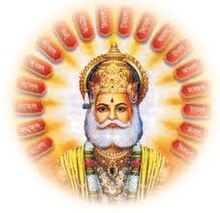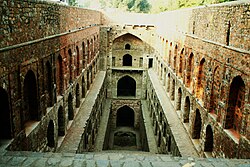


Maharaja Agrasen, the legendary king who was the forefather of Agrawals
| |
| Regions with significant populations | |
|---|---|
| India, Pakistan, and Nepal | |
| Languages | |
| Hindi, Rajasthani, Punjabi, Haryanvi | |
| Religion | |
| Majority: Vaishnava Hinduism, Jainism, Sikhism Minority: Islam, Christianity[1][2] |
Agrawal (anglicisedasAgarwal, Agerwal, Agrawala, Agarwala, Agarwalla, Aggarwal, AgarawalorAgarawala) is a Hindu Bania community.[3] The Banias of northern India are really a cluster of several communities, of which the Agarwal Banias, Maheshwari Banias, Oswal Banias, and Porwal Banias are mentioned separately in connection with certain[4] They are found throughout northern and central India, mainly in the states of Rajasthan, Haryana, Punjab, Jammu and kashmir, Chandigarh, Himachal Pradesh, Uttarakhand, Delhi, Chhattisgarh, Gujarat, Maharashtra and Uttar Pradesh. They are also found in Pakistani provinces of Punjab and Sindh, though at the time of the partition of India, most of them migrated across the newly created border to independent India.[5][6][7] The majority religions followed by the Agrawals include Vaishnava Hinduism and Jainism.[1][8][2]
It is said[who?] that the ancestor of Agrawal Samaj, Maharaja AgrasenaKshatriya king, is one of the descendants of the Sanatan deity Shri Ram and their prime goddess was goddess Lakshmi Mahalaxmi who has given boon to the king and his descendants to be prosperous always by her and consort God Vishnu's kindness. Maharaja Agrasen was the king of Agroha Kingdom. This community is also known as one of the earliest business establishers.
Agrawals are Suryavamsha and belongs to Raghuvamsha house.[citation needed] Members of the Agrawal community are known for their business acumen and have for many years been influential and prosperous in India. Even in modern-day tech and ecommerce companies, they continue to dominate. It was reported in 2013, that for every 100 in funding for e-commerce companies in India, 40 went to firms founded by Agrawals.[9]

Agrawals are one of the Bania (merchant) communities in India, which includes other mercantile communities like Maheshwari , Baranwals and Oswals.[11][12]
In inscriptions and texts, the original home of the Agrawal community is stated as Agroha, near Hisar, Haryana.
Some of the Agarwals adapted Jainism under the influence of Lohacharya.[16]
The Agrawal merchant Nattal Sahu, and the Agrawal poet Vibudh Shridhar lived during the reign of Tomara King Anangapal of Yoginipur (now Mehrauli, near Delhi).[17] Vibudh Shridhar wrote Pasanahacariu in 1132 AD, which includes a historical account of Yoginipur (early Delhi near Mehrauli) then.
In 1354, Firuz Shah Tughluq had started the construction of a new city near Agroha, called Hisar-e-Feroza ("the fort of Firuz"). Most of the raw material for building the town was brought from Agroha.[18] The town later came to be called Hisar. Hisar became a major center of the Agrawal community. Some Agrawals are also said to have moved to the Kotla Firoz Shah fort in Delhi, built by Firuz Shah Tughlaq.
During the era of Islamic administrative rule in India, some Agrawal, as with the Saraogi, migrated to the Bikaner State.[citation needed] The Malkana include Muslim Agrawals, who converted from Hinduism to Islam during this time and were given land tracts along the Yamuna by Afghan rulers.[2]
In the early 15th century, Agrawals flourished under the Tomaras of Gwalior.[19][full citation needed] According to several Sanskrit inscription at the Gwalior FortinGwalior District, several traders (Sanghavi Kamala Simha, Khela Brahmachari, Sandhadhip Namadas etc.) belonging to Agrotavansha (Agrawal clan) supported the sculptures and carving of idols at the place.[20] Historian K.C. Jain comments:
Golden Age of the Jain Digambar Temple in Gwalior under the Tomara rulers inspired by the Kashtha Bhattarakas and their Jaina Agrawal disciples who dominated the Court of father and son viz. Dungar Singh (1425-59)and Kirti Singh (1459–80) with the Poet-Laureate Raighu as their mouthpiece and spokesman, a centenarian author of as many as thirty books, big and small of which two dozen are reported to be extant today. Verify the advent of the Hisar-Firuza-based Jain Agrawals who functioned as the ministers and treasurers of the ruling family had turned the Rajput State of Gwalior into a Digambara Jain Centre par excellence representing the culture of the Agrawal multi-millionner shravakas as sponsored by them.[19]
Later, during the Mughal rule, and during the British East India Company administration, some Agrawals migrated to Bihar and Calcutta, who became the major component of the Marwaris.[21][page needed]
Agrawals belong to various gotras, traditionally said to be seventeen and a half in number. According to Bharatendu Harishchandra's Agarwalon ki Utpatti (1871), Agrasen - the legendary progenitor of the community - performed 17 sacrifices and left the eighteenth incomplete, resulting in this number. Bharatendu also mentions that Agrasen had 17 queens and a junior queen, but does not mention any connection between the number of gotras and the number of queens, or describe how the sacrifices led to the formation of the gotras.[22] Another popular legend claims that a boy and girl from the Goyan gotra married each other by mistake, which led to the formation of a new "half" gotra. Another popular belief that since Maharaj Agrasen has 17 son and one daughter so where his daughter was married the gotra of daughter in laws were adopted as half gotra in Agrawals, thus 17.5 gotra. [23]
Historically, there has been no unanimity regarding number and names of these seventeen and a half gotras, and there are regional differences between the list of gotras. The Akhil Bhartiya Agrawal Sammelan, a major organization of Agrawals, has created a standardized list of gotras, which was adopted as an official list by a vote at the organization's 1983 convention.[24] Because the classification of any particular gotra as "half" is considered insulting, the Sammelan provides a list of following 18 gotras:[25]
The existence of all the gotras mentioned in the list is controversial, and the list does not include several existing clans such as Kotrivala, Pasari, Mudgal, Tibreval, and Singhla.[26][need quotation to verify]
Some subsects of the Oswals and Agarwals were converted to Jainism in the 16th century.
Agarwal recounts how the news of his own conversion was greeted by his grandmother in Punjab...
Resembling Tughlak period architectures, it was probably constructed by the Agrawal community (tracing back to Maharaja Agrasen).
The Banias of northern India are really a cluster of several communities, of which the Agarwal Banias, Oswal Banias, and Porwal Banias are mentioned separately in connection with certain surnames.
{{cite book}}: CS1 maint: location (link)
The bulk of the Agrawals belong to Vaishnava sect of Hinduism. ... Agrawals, it is believed, were converted to Jainism by Sri Loha Charyaji between 27 and 77 years of the Vikram era.
| Authority control databases: National |
|
|---|
|
| |||||||||||||
|---|---|---|---|---|---|---|---|---|---|---|---|---|---|
| Hindu and Jain communities |
| ||||||||||||
| Muslim communities |
| ||||||||||||
|
| |||||||||||||
|---|---|---|---|---|---|---|---|---|---|---|---|---|---|
| Hindu Communities |
| ||||||||||||
| Jain communities |
| ||||||||||||
| Muslim communities |
| ||||||||||||
| Other communities |
| ||||||||||||